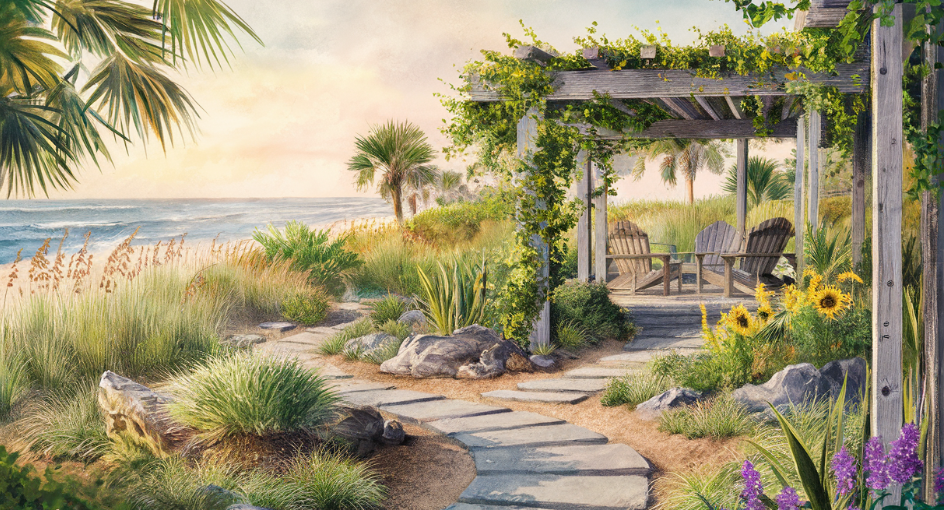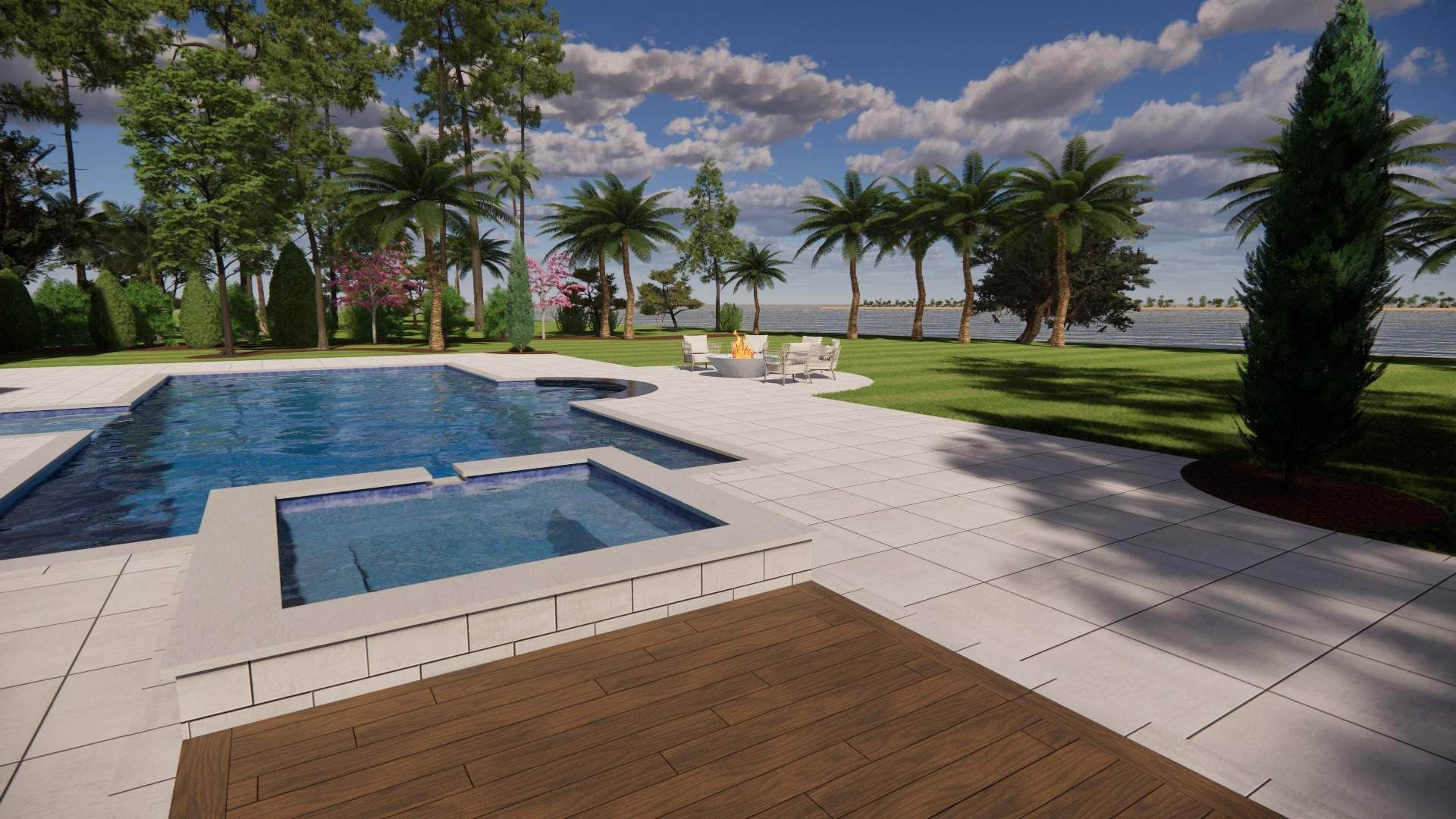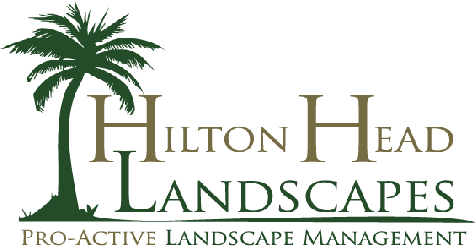Coastal Garden Design: Creating a Seaside Oasis in Hilton Head

Coastal garden design transforms your outdoor space into a serene seaside retreat. For Hilton Head Island residents, this approach blends native plants, salt-tolerant species, and beach-inspired elements to craft a low-maintenance landscape that thrives in the unique coastal environment.
Key Takeaways:
- Use native plants and salt-tolerant species for a resilient garden
- Incorporate beach-inspired elements like driftwood and seashells
- Create windbreaks to protect plants from strong ocean breezes
- Use raised beds and sandy soil to improve drainage
- Add outdoor living spaces to enjoy the coastal views
- Choose low-maintenance plants that can withstand salt spray
- Use natural materials like stone and wood for hardscaping
Understanding Hilton Head's Coastal Environment
Hilton Head Island's unique climate and geography shape its gardening needs. The island experiences hot summers, mild winters, and high humidity. Salt spray from the ocean affects plant growth, while sandy soils present drainage challenges.
Impact of Salt and Wind on Plants
Salt spray can damage plants not adapted to coastal conditions. It can cause leaf burn, stunted growth, and even plant death. Strong ocean winds also stress plants, making wind-resistant species essential for a thriving coastal garden.
Soil Conditions on Hilton Head
Hilton Head's sandy soil drains quickly, which can be both a blessing and a challenge. While good drainage prevents waterlogging, it also means nutrients and water leach out rapidly. Amending the soil with organic matter helps retain moisture and nutrients.
Selecting Plants for Your Coastal Garden
Choosing the right plants is crucial for a successful coastal garden on Hilton Head Island. Native and salt-tolerant species are your best bet for a low-maintenance, thriving landscape.
Native Plants for Hilton Head Gardens
Native plants are adapted to local conditions and require less maintenance. Some excellent choices for Hilton Head include:
- Sea oats (Uniola paniculata)
- Yaupon holly (Ilex vomitoria)
- Sweetgrass (Muhlenbergia filipes)
- Cabbage palmetto (Sabal palmetto)
Salt-Tolerant Non-Native Species
While native plants are ideal, some non-native species also thrive in coastal conditions:
- Oleander (Nerium oleander)
- Pittosporum (Pittosporum tobira)
- Bougainvillea (Bougainvillea glabra)
- Lantana (Lantana camara)
Creating a Windbreak for Plant Protection

A windbreak is essential in a coastal garden to shield plants from strong ocean breezes. It also helps reduce salt spray damage to more sensitive plants.
Natural Windbreak Options
Consider planting a row of salt-tolerant trees or shrubs as a natural windbreak. Good choices include:
- Wax myrtle (Morella cerifera)
- Southern red cedar (Juniperus virginiana)
- Live oak (Quercus virginiana)
Artificial Windbreak Solutions
For quicker results or in areas where planting isn't feasible, consider artificial windbreaks:
- Wooden fences
- Lattice screens
- Beach grass plantings
Designing Your Coastal Garden Layout
A well-planned layout ensures your coastal garden is both beautiful and functional. Consider the following elements when designing your space.
Zoning for Plant Protection
Create zones in your garden based on exposure to wind and salt spray. Place the most salt-tolerant plants in the most exposed areas, with more sensitive species in sheltered spots.
Incorporating Outdoor Living Spaces
Make the most of Hilton Head's climate by including outdoor living areas in your garden design. Consider adding:
- A covered patio for shade
- An outdoor kitchen for entertaining
- A fire pit for cooler evenings
Using Beach-Inspired Elements in Your Garden
Bring the beach into your garden with coastal-themed decorative elements. These touches create a cohesive seaside atmosphere.
Natural Beach Decor
Incorporate found objects from the beach into your garden design:
- Driftwood as garden art or planters
- Seashells as mulch or pathway accents
- Beach pebbles for drainage in pots
Coastal Color Palette
Use colors inspired by the beach in your plant choices and garden accessories:
- Sandy beiges
- Ocean blues
- Driftwood grays
- Sea glass greens
Hardscaping for Coastal Gardens

Hardscaping elements add structure and functionality to your coastal garden. Choose materials that complement the seaside theme and withstand the coastal environment.
Choosing Appropriate Materials
Select materials that can handle salt exposure and frequent moisture:
- Natural stone like granite or limestone
- Pressure-treated wood
- Composite decking
- Concrete pavers
Drainage Solutions for Sandy Soil
Proper drainage is crucial in Hilton Head's sandy soil. Consider these hardscaping elements to manage water flow:
- Permeable pavers
- Gravel pathways
- Rain gardens
- French drains
Maintaining Your Coastal Garden
A well-designed coastal garden requires less maintenance, but some upkeep is still necessary to keep it looking its best.
Watering Strategies for Sandy Soil
Sandy soil drains quickly, so efficient watering is key:
- Use drip irrigation for targeted watering
- Water deeply but less frequently
- Mulch heavily to retain moisture
Pruning and Plant Care
Regular pruning helps maintain plant health and shape:
- Trim back salt-damaged foliage
- Shape wind-resistant hedges
- Remove dead or diseased branches promptly
Seasonal Considerations for Hilton Head Gardens
Hilton Head's climate allows for year-round gardening, but each season brings its tasks and opportunities.
Spring Planting and Preparation
Spring is the ideal time for new plantings and garden prep:
- Add organic matter to the soil
- Plant new shrubs and perennials
- Start summer vegetable gardens
Summer Heat Management
Hilton Head summers can be intense. Help your garden cope with the heat:
- Mulch heavily to retain moisture
- Provide shade for sensitive plants
- Water early in the morning or late in the evening
Fall and Winter Garden Tasks
Even in Hilton Head's mild winters, some garden tasks are necessary:
- Plant cool-season annuals
- Prune deciduous trees and shrubs
- Protect tender plants from occasional frost
Eco-Friendly Practices for Coastal Gardens
Sustainable gardening practices help protect Hilton Head's delicate coastal ecosystem.
Water Conservation Techniques
Conserve water in your coastal garden:
- Collect rainwater for irrigation
- Group plants with similar water needs
- Use drought-tolerant species
Natural Pest Control Methods
Avoid chemical pesticides that can harm beneficial insects and marine life:
- Encourage natural predators like ladybugs
- Use companion planting to deter pests
- Hand-pick pests when possible
Enhancing Biodiversity in Your Coastal Garden
A diverse garden supports local wildlife and creates a more resilient ecosystem.
Attracting Pollinators and Birds
Create a haven for local wildlife:
- Plant nectar-rich flowers for butterflies and hummingbirds
- Include berry-producing shrubs for birds
- Provide water sources like birdbaths or shallow ponds
Creating Wildlife Habitats
Designate areas in your garden for wildlife:
- Leave some areas unmowed for ground-nesting birds
- Create brush piles for small animals
- Install birdhouses and bat boxes
Coastal Garden Lighting
Proper lighting extends the enjoyment of your coastal garden into the evening hours.
Solar-Powered Options
Solar lights are eco-friendly and easy to install:
- Path lights for safety
- Accent lights for trees and shrubs
- String lights for ambiance
Light Pollution Considerations
Be mindful of light pollution, especially if you live near the beach:
- Use downward-facing fixtures to reduce glare
- Choose warm-colored bulbs to minimize impact on wildlife
- Install timers or motion sensors to limit unnecessary lighting
Container Gardening for Coastal Spaces
Container gardens offer flexibility and can thrive in coastal conditions.
Choosing the Right Containers
Select containers that can withstand coastal elements:
- Glazed ceramic pots resist salt damage
- Lightweight plastic or fiberglass planters are easy to move
- Self-watering containers help with moisture retention
Plant Selection for Containers
Choose plants that do well in containers and coastal conditions:
- Succulents like sedum and echeveria
- Ornamental grasses like fountain grass
- Herbs like rosemary and thyme
Growing food in your coastal garden is possible with the right approach.
Salt-Tolerant Herbs and Vegetables
Some edible plants thrive in coastal conditions:
- Rosemary
- Thyme
- Sea kale
- Swiss chard
Creating a Coastal Kitchen Garden
Design a productive and attractive kitchen garden:
- Use raised beds to improve soil conditions
- Incorporate herbs into ornamental plantings
- Plant fruit trees as landscape features
Here's a list of salt-tolerant edible plants suitable for Hilton Head coastal gardens:
- Rosemary
- Thyme
- Oregano
- Sea kale
- Swiss chard
- Artichokes
- Asparagus
- Figs
- Pomegranates
Embracing the Coastal Garden Lifestyle
A well-designed coastal garden becomes an extension of your home, offering a space to relax and connect with nature.
Creating Outdoor Rooms
Design your garden as a series of outdoor rooms:
- A dining area for al fresco meals
- Lounge space for relaxation
- A meditation corner for quiet reflection
Incorporating Water Features
Water features add a soothing element to your coastal garden:
- A small fountain for ambient sound
- A reflective pool for visual interest
- A naturalistic stream to mimic coastal waterways
Source
- Using native plants is an effective coastal garden design strategy. Native plants are well-adapted to the local climate and soil conditions, reducing the need for frequent watering and fertilization. (Source)
- Incorporating drought-tolerant plants is another important strategy for coastal garden design. Due to the high evapotranspiration rates in coastal areas, water conservation is crucial. (Source)
- Using stones, gravel, or other hardscapes in the garden design can help reduce water usage and maintenance. These materials also add visual interest and texture to the garden. (Source)
- Planting in raised beds or mounds can help improve drainage and prevent root rot in coastal gardens. This is especially important in areas with high rainfall or poor soil drainage. (Source)
- Using windbreaks, such as hedges or fences, can help protect coastal gardens from damaging winds. This can reduce the need for additional watering and help prevent soil erosion. (Source)
By following these guidelines, you can create a stunning coastal garden that thrives in Hilton Head's unique environment. Your seaside oasis will provide beauty, functionality, and a connection to the island's natural landscape for years to come. For more information, you can visit our website or contact us.

HOURS OF OPERATION:
- Mon - Fri
- -
- Sat - Sun
- Closed
All Rights Reserved | Hilton Head Landscapes | Website Created by: Kickstart Local


